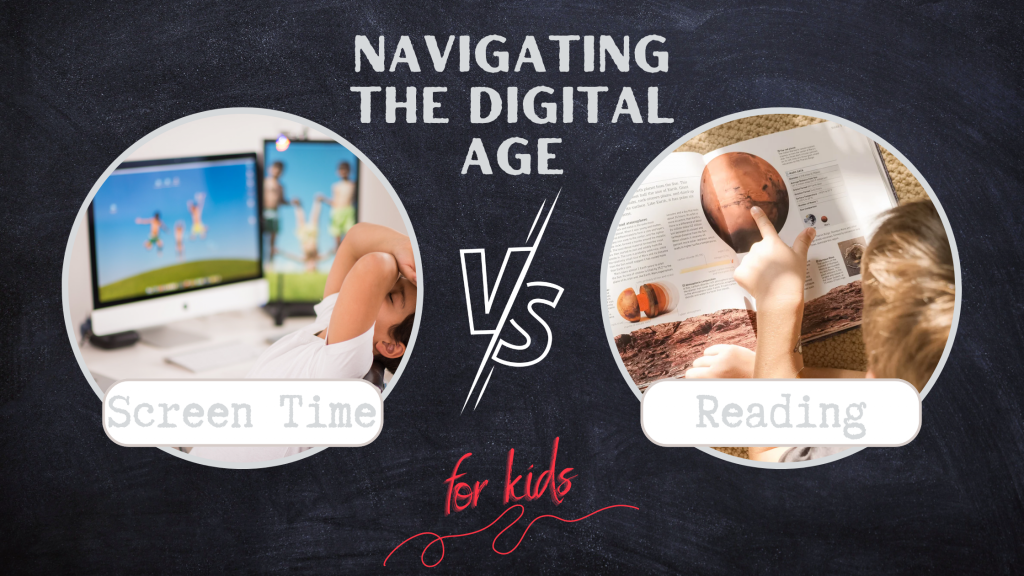In today’s digital age, where screens seem to dominate every aspect of our lives, it is crucial to strike a balance between screen time and other activities, such as reading, especially when it comes to our children. As parents and caregivers, we play a vital role in guiding our kids towards a healthy relationship with technology while also nurturing their love for reading. In this article, we will explore the importance of balancing screen time with reading and provide valuable tips to help you achieve this delicate equilibrium.
Why Balance is Essential
While the digital landscape offers numerous opportunities for learning and entertainment, excessive screen time can have adverse effects on children’s development. Research has shown that prolonged exposure to screens can lead to a sedentary lifestyle, sleep disturbances, decreased social interaction, and even developmental delays. On the other hand, reading promotes cognitive skills, language development, and imagination. It enhances critical thinking, empathy, and creativity, allowing children to explore different worlds and expand their horizons.
Creating a Healthy Screen Time Routine
Establishing a healthy screen time routine is paramount to ensure children get the best of both worlds – the benefits of technology and the joys of reading. Here are some practical tips to help you create a balanced routine:
- Set Clear Boundaries: Define specific time limits for screen usage and communicate these boundaries to your children. This clarity will help them understand expectations and develop self-regulation skills.
- Encourage Educational Content: Encourage the use of educational apps, websites, and programs that promote learning through engaging and interactive content. These tools can complement traditional reading materials and make the screen time more valuable.
- Prioritize Quality over Quantity: Rather than focusing solely on the duration of screen time, pay attention to the quality of the content consumed. Opt for age-appropriate, educational, and thought-provoking material that sparks curiosity and encourages critical thinking.
- Engage in Co-Viewing or Co-Reading: Whenever possible, engage in co-viewing or co-reading sessions with your child. This allows you to monitor the content together, discuss key points, and foster a deeper understanding of what they are watching or reading.
- Create Device-Free Zones: Designate certain areas in your home, such as the dining table or the bedroom, as device-free zones. This practice encourages face-to-face interactions, family bonding, and promotes the habit of reading physical books.
Fostering a Love for Reading
Now that we’ve discussed the importance of balancing screen time let’s explore effective strategies to foster a love for reading in children:
- Lead by Example: Children often imitate the behavior of adults around them. Show your love for reading by making it a visible part of your daily routine. Set aside time for reading, discuss books with enthusiasm, and let your child see your enjoyment of the written word.
- Create a Reading-Friendly Environment: Make reading an inviting and cozy experience for your child. Set up a comfortable reading nook with cushions, blankets, and a bookshelf filled with a diverse selection of age-appropriate books. Involve your child in choosing new books and encourage them to explore different genres.
- Make Reading Interactive: Enhance the reading experience by making it interactive. Encourage your child to ask questions, make predictions, and share their thoughts and feelings about the story. This dialogue not only strengthens their comprehension skills but also makes reading a more engaging activity.
- Visit Libraries and Bookstores: Regular visits to libraries and bookstores expose children to a wide range of books and inspire a sense of curiosity. Encourage them to select their own books, participate in storytelling sessions, or join book clubs tailored to their
- Integrate Reading into Daily Activities: Find opportunities to incorporate reading into daily activities. For example, you can read a bedtime story together, encourage your child to read recipes while cooking, or even explore informational books related to their hobbies or interests. By integrating reading into various aspects of their lives, you make it a natural and enjoyable habit.
- Celebrate Reading Milestones: Acknowledge and celebrate your child’s reading achievements. Whether it’s finishing a challenging book or reaching a certain number of books read, reward their efforts with praise, a special treat, or a trip to a bookstore. This positive reinforcement reinforces their love for reading and motivates them to continue exploring new books.
- Join Reading Programs and Challenges: Engage your child in reading programs or challenges organized by schools, libraries, or online platforms. These initiatives provide incentives, such as certificates or prizes, and create a sense of excitement and friendly competition. They also expose children to a wider reading community and encourage them to expand their literary horizons.
- Encourage Peer Interaction: Foster peer interaction centered around reading by encouraging your child to join book clubs or reading groups at school or in the community. These forums not only provide an opportunity to discuss books but also enhance social skills and develop friendships with like-minded individuals.
Conclusion
We hope this article has provided valuable insights into balancing screen time with reading for kids. If you want to explore more engaging content and tips on nurturing your child’s development, we invite you to follow us on Pinterest. Our Pinterest boards are filled with exciting blog posts and resources to support you on this journey. Join our community of parents and caregivers who are passionate about raising well-rounded individuals.
Additionally, don’t forget to check out some of our other blogs on our website. We cover a wide range of topics related to parenting, education, and child development. We strive to provide comprehensive and reliable information that empowers you to make informed decisions for your child’s well-being.
We value your feedback and would love to hear your thoughts. Leave us a comment below with your experiences, tips, or any questions you may have. We believe in the power of collective wisdom, and your insights can contribute to a vibrant community of readers and caregivers.
Remember, striking a balance between screen time and reading is a continuous effort. By fostering a love for reading and setting healthy boundaries, we can equip our children with the tools to navigate the digital age while embracing the joys of literature.


Pingback: 10 kids Bedtime Stories: powerful books for peaceful sleeps